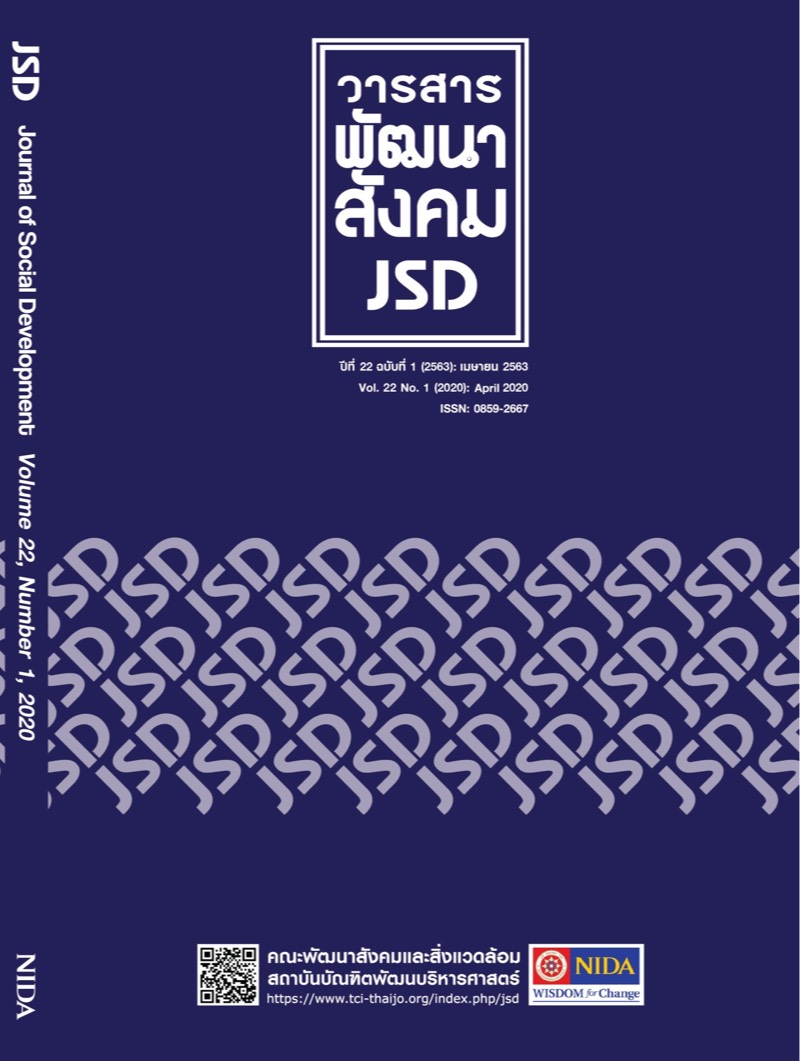Fiscal Policy to Promote Efficiency and Quality of Life of the Working Elderly
Main Article Content
Abstract
Article Details
References
Adams, S. J. (2004). “Age discrimination legislation and the employment of older workers,” Labour Economics, 11(2), 219-241.
Advisory Council on National Labor Development. (2013). Research Project on the Promotion of Job Opportunities for the Elderly (in Thai). Office of Permanent Secretary, Ministry of Labor.
Behaghel, L et al (2014). “Age-biased technical organizational change, training and employment prospects of older workers,” Economica, 80, 368-389.
Bell, D. N.F. & A.C. Rutherford. (2013). Older workers and working time. Discussion Paper No. 7546, Forschungsinstitutzur Zunkunft der Arbeit (Institute for the Study of Labor), August.
Belloni, M. & C. Villosio (2014). “Training and wages of older workers in Europe,” European Journal of Ageing, 2(1), 7-16.
Belloni et al. (2015). “Does training help retaining older workers into employment? Evidence from the SHARE survey,” in Eds
Block, J. & P. Koellinger (2009). “I can’t get no satisfaction- Necessity entrepreneurship andprocedural utility,” Kyklos,6(2),191-209.
Borsch-Supan et al. Ageing in Europe-Supporting policies for an inclusive society. Berlin: Walter de Gruyter Gmbh& Co. KG, 257-266.
Borsch-Supan, A. & R. Schnabel (1998). “Social security and declining labour force participation in Germany,” American Economic Review, 88(2), 173-8.
Borsch-Supan, A. & R. Schnabel (2010). “Early retirement and employment of the young in Germany,” In . (Eds.) J. Gruber and D. A. Wise Social security and retirement around the world: The Relationship to Youth Employment, 147-166. Chicago: University of Chicago Press.
Bosworth, B. (2005). Economic Growth in Thailand: A Macroeconomic Context. Paper Prepared for a World Bank Project on Investment Climate, Firm Competitiveness and Growth.
Chawla, A. (2008). Macroeconomic aspects of demographic changes and intergenerational transfers in Thailand. Unpublished PhD dissertation, University of Hawaii at Manoa.
Dearden, L. et al (2006) “The impact of training on productivity and wages: evidence from British panel data,” Oxford Bulletin of Economics and Statistics, 68(4), 397-421.
Eichhorst, W. (2011). The transition from work to retirement. Discussion Paper No. 5490, ForschungsinstitutzurZunkunft der Arbeit (Institute for the Study of Labor), February.
Eurofound. (2012). Employment trends and policies for older workers in the recession. Publications Office of the European Union, Luxembourg.
Floden, M. (2001). Ageing populations and strategies for public debt in Europe. The scope and size of the public sector project. Stockholm: SNS (Center for Business and Policy Studies).
Gruber, J. & D. A. Wise (2005). “Social security programs and retirement around the world: fiscal implications, introduction and summary” NBER Working Paper 11290, Massachusetts: National Bureau of Economic Research, April.
International Longevity Center, Japan (2013). A Profile of Older Japanese 2013. Tokyo: International Longevity Center (Japan), March.
Jitapunkul, S. & S. Wivatvanit (2009). National policies and programs for the ageing population in Thailand,” Ageing International, 33(1), 62-74.
Lahey, J. (2006). State age protection laws and the age discrimination in employment act. Working Paper No. w12048. National Bureau of Economic Research.
Magnavita, N. (2017). “Productive aging , work engagement and participation of older workers.A triadic approach to health and safety in the workplace,” Epidemiology Biostatics and Public Health, 14(2), e12436.1- e12461.8.
Mankiw, N.G., D. Romer and D. Weil (1992). “A Contribution to the Empirics of Economic Growth.” Quarterly Journal of Economics, 107(2) 407-437.
Meadows, P. (2003). Retirement ages in the UK: A review of the literature, Employment Relations Research Series No. 18, London: Department of Trade and Industry.
Myck, M. (2015). “Living longer, working longer: the need for a comprehensive approach to labour market reform in response to demographic changes,” European Journal of Ageing, 12(1), 3-5.
National Board of Promotion and Coordination for the Elderly. (2002). The 2nd National Policy for Old Age (2002-2021) (in Thai). Bangkok: Office of the Prime Minister.
Organization of Economic Co-operation and Development. (2006). Live longer, work longer. OECD Report.
Ortego, J. D. & C. T. Farley (2015). “Effects of aging on mechanical efficiency and muscle activation during level and uphill walking,” Journal of Electromyography and Kinesiology, 5(1), 193-198.
Pischke, J.S. (2001). “Continuous training in Germany,” Journal of Population Economics, 14(3), 52-548.
Phijaisanit, E. (2011). Tax Treaties in Asia Pacific Economic Integration & Cross-Country Fiscal Implications (In Thai). Final Report. Office of the Higher Education Commission and The Thai Research Fund.
Phijaisanit, E. (2015) “Desired ageing society and corresponding public finance: a scenario analysis for Thailand,” (In Thai). Paper presented at Symposium No. 38, Annual Economic Conference Proceeding, Faculty of Economics, Thammasat University.
Pholphirul, P. (2005). “Competitiveness, income distribution and growth in Thailand: What does the long-run evidence show?” International Relations Program, TDRI, May.
Prajuabmoh, et al (2009). Project Report on the Tracking and Evaluation System of the 2nd National Policy for Old Age (2002-2021) (in Thai). College of Population Studies, Chulalongkorn University.
Prasitsiriphon, O. F. Jeger, A. Tharachompoo & T. Sakunphanit (2013). Costing model for long-term care system in Thailand. Bangkok: Health System Research Office.
Sakunphanit, T. (2006). Thailand: Universal health care coverage through pluralistic approaches. Health Care Reform Project, National Health Security Office, Thailand.
Schmitt, V. (2011). Overview of the Rapid Assessment Protocol (Costing tool). Assessment National Dialogue No. 2, Bangkok: International Labour Organisation.
Solow, R. M. (1956). “A contribution to the theory of economic growth,” Quarterly Journal of Economics, 70(1), 65-94.
Sonnet, A. H. Olsen & T. Manfredi (2014). “Towards more inclusive ageing and employment policies:the lessons from France, The Netherlands, Norway and Switzerland,” DeEconomist, December, 162, 315-339.
Srinivansan, T.N. (1988) “Population Growth and Economic Development.” Journal of Policy Modelling, 10(1) 7-28.
Suwanrada, W. (2015). Pension Reform and Fiscal Sustainability (in Thai). Presented at BOT Symposium 2015. United Nations, Department of Economic and Social Affairs, Population Division (2013). World population ageing 2013. ST/ESA/SER.A/348.


